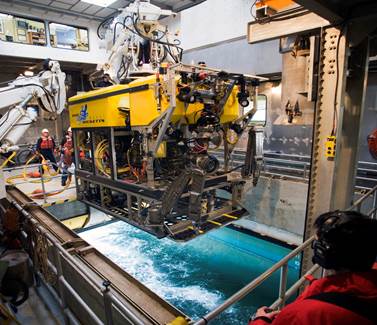Explore the deep sea in re-imagined 'Mission to the Deep' exhibit at Monterey Bay Aquarium

Embark on a virtual deep-sea expedition starting November 22 when the Monterey Bay Aquarium opens its re-imagined “Mission to the Deep” exhibit, highlighting the valuable work of its partners at the Monterey Bay Aquarium Research Institute (MBARI).
MBARI is a world leader in developing new technologies for expanding ocean science and conservation. Its findings are advancing understanding of how the living ocean functions and how humans are affecting this vital habitat, which comprises 99 percent of the living space on Earth.
Inside the new “Mission to the Deep” a 360-degree video projection of the mile-deep Monterey Canyon immerses visitors in a simulated underwater world. In this otherworldly setting, visitors discover how MBARI’s scientists and engineers use revolutionary new technologies to study the ocean.
Overhead, a half-scale model of MBARI’s undersea robot, the remotely operated vehicle Doc Ricketts, shines a spotlight around a virtual underwater landscape, revealing videos of mesmerizing deep-sea animals such as vampire squids, sea toads, and jellies that grow more than three feet across. The program also highlights the latest technological tools developed by MBARI engineers, including an autonomous underwater vehicle that MBARI researchers use to explore alien environments.
“MBARI is so much more than discovering unusual animals,” said Senior Exhibit Developer Raúl Nava. “This exhibit shows how the institute is monitoring the pulse of the ocean, and its incredible – and fragile – biodiversity. We can’t protect the deep sea if we don’t know what’s down there.”
Interactive displays in the center of the exhibit let visitors take a simulated dive deep into Monterey Canyon. Visitors control the dive, and can stop at different depths to learn more about the animals or research equipment they see along the way.
George Matsumoto, an MBARI researcher and member of the exhibit team, commented, “The Monterey Bay Aquarium provides an unparalleled outlet for education and outreach about MBARI's research and engineering efforts. Working with the talented aquarium exhibit team was a rewarding and engaging experience.”
The remodeled “Mission to the Deep” exhibit is a companion to the aquarium’s daily “Mysteries of the Deep” auditorium program, in which presenters use high-definition video to share with visitors what MBARI researchers experience on a regular basis: the fantastic animals and mysterious environments of the deep sea.
– 30 –
The Monterey Bay Aquarium Research Institute (MBARI) is a private, non-profit research institution where scientists and engineers work together to develop new instruments and methods for studying the ocean. Located in Moss Landing, California, MBARI is supported primarily by the David and Lucile Packard Foundation.
The nonprofit Monterey Bay Aquarium celebrates its 30th anniversary in 2014, with a mission to inspire conservation of the oceans.
Editors: Please visit our online Newsroom to register for access to download high-res photos, press releases, and other assets.
Media Contact
All latest news from the category: Earth Sciences
Earth Sciences (also referred to as Geosciences), which deals with basic issues surrounding our planet, plays a vital role in the area of energy and raw materials supply.
Earth Sciences comprises subjects such as geology, geography, geological informatics, paleontology, mineralogy, petrography, crystallography, geophysics, geodesy, glaciology, cartography, photogrammetry, meteorology and seismology, early-warning systems, earthquake research and polar research.
Newest articles

Silicon Carbide Innovation Alliance to drive industrial-scale semiconductor work
Known for its ability to withstand extreme environments and high voltages, silicon carbide (SiC) is a semiconducting material made up of silicon and carbon atoms arranged into crystals that is…

New SPECT/CT technique shows impressive biomarker identification
…offers increased access for prostate cancer patients. A novel SPECT/CT acquisition method can accurately detect radiopharmaceutical biodistribution in a convenient manner for prostate cancer patients, opening the door for more…

How 3D printers can give robots a soft touch
Soft skin coverings and touch sensors have emerged as a promising feature for robots that are both safer and more intuitive for human interaction, but they are expensive and difficult…




















